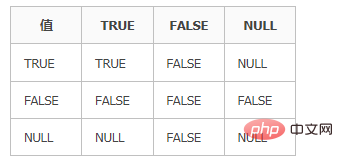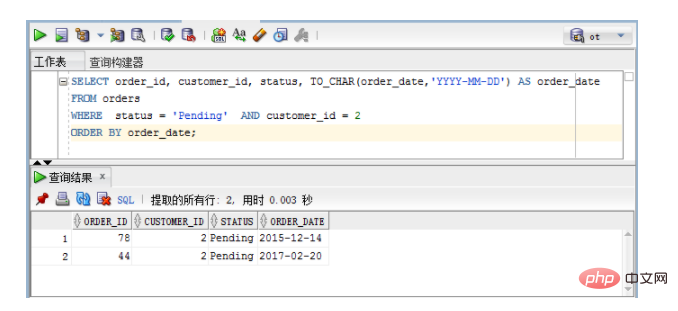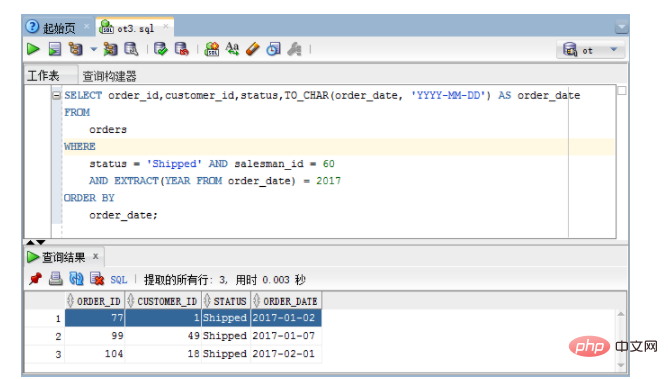What is the usage of and in oracle
In Oracle, and is a logical operator, which means "and". It is used to filter the specified conditions. Only when the conditions before and after and are satisfied, the returned result is true. If one of the If the conditional expression is false, the and operator returns false.

The operating environment of this tutorial: Windows 10 system, Oracle 11g version, Dell G3 computer.
What is the usage of and in oracle
The AND operator is a logical operator that combines Boolean expressions and returns true if both expressions are true. The AND operator returns false if one of the expressions is false.
The syntax of the AND operator is as follows:
expression_1 AND expression_2
The following table illustrates the results when using the AND operator to combine true, false, and NULL values:

Normally, AND is used in the WHERE clause of SELECT, DELETE, and UPDATE statements to form conditions for matching data. Additionally, use the AND operator in the predicate of the JOIN clause to form the join condition.
When using multiple logical operators in a declaration, Oracle always evaluates the AND operator first. However, you can use parentheses to change the order of evaluation.
Oracle AND Operator Example
Take the orders table in the following database as an example:

1. Oracle AND combination Examples of two Boolean expressions
The following example finds those orders with a customer number of 2 that have a status of Pending:
SELECT order_id, customer_id, status, TO_CHAR(order_date,'YYYY-MM-DD') AS order_date FROM orders WHERE status = 'Pending' AND customer_id = 2 ORDER BY order_date;
In this example, the query returns the order that satisfies the two All order information of expressions, that is:
status = 'Pending' and customer_id = 2
Executing the above code can get the following results:

2. Example of Oracle AND combining two or more Boolean expressions
You can use multiple AND operators to combine Boolean expressions.
For example, the following statement retrieves orders that meet all of the following conditions:
Placed in 2017.
The number of the salesperson in charge is 60.
has shipping status.
Refer to the following query statement:
SELECT
order_id,
customer_id,
status,
TO_CHAR(order_date, 'YYYY-MM-DD') AS order_date
FROM
orders
WHERE
status = 'Shipped'
AND salesman_id = 60
AND EXTRACT(YEAR FROM order_date) = 2017
ORDER BY
order_date;Execute the above code to get the following results:

Recommended tutorial: "Oracle Tutorial》
The above is the detailed content of What is the usage of and in oracle. For more information, please follow other related articles on the PHP Chinese website!

Hot AI Tools

Undresser.AI Undress
AI-powered app for creating realistic nude photos

AI Clothes Remover
Online AI tool for removing clothes from photos.

Undress AI Tool
Undress images for free

Clothoff.io
AI clothes remover

Video Face Swap
Swap faces in any video effortlessly with our completely free AI face swap tool!

Hot Article

Hot Tools

Notepad++7.3.1
Easy-to-use and free code editor

SublimeText3 Chinese version
Chinese version, very easy to use

Zend Studio 13.0.1
Powerful PHP integrated development environment

Dreamweaver CS6
Visual web development tools

SublimeText3 Mac version
God-level code editing software (SublimeText3)

Hot Topics
 What to do if the oracle can't be opened
Apr 11, 2025 pm 10:06 PM
What to do if the oracle can't be opened
Apr 11, 2025 pm 10:06 PM
Solutions to Oracle cannot be opened include: 1. Start the database service; 2. Start the listener; 3. Check port conflicts; 4. Set environment variables correctly; 5. Make sure the firewall or antivirus software does not block the connection; 6. Check whether the server is closed; 7. Use RMAN to recover corrupt files; 8. Check whether the TNS service name is correct; 9. Check network connection; 10. Reinstall Oracle software.
 How to solve the problem of closing oracle cursor
Apr 11, 2025 pm 10:18 PM
How to solve the problem of closing oracle cursor
Apr 11, 2025 pm 10:18 PM
The method to solve the Oracle cursor closure problem includes: explicitly closing the cursor using the CLOSE statement. Declare the cursor in the FOR UPDATE clause so that it automatically closes after the scope is ended. Declare the cursor in the USING clause so that it automatically closes when the associated PL/SQL variable is closed. Use exception handling to ensure that the cursor is closed in any exception situation. Use the connection pool to automatically close the cursor. Disable automatic submission and delay cursor closing.
 How to paginate oracle database
Apr 11, 2025 pm 08:42 PM
How to paginate oracle database
Apr 11, 2025 pm 08:42 PM
Oracle database paging uses ROWNUM pseudo-columns or FETCH statements to implement: ROWNUM pseudo-columns are used to filter results by row numbers and are suitable for complex queries. The FETCH statement is used to get the specified number of first rows and is suitable for simple queries.
 How to create cursors in oracle loop
Apr 12, 2025 am 06:18 AM
How to create cursors in oracle loop
Apr 12, 2025 am 06:18 AM
In Oracle, the FOR LOOP loop can create cursors dynamically. The steps are: 1. Define the cursor type; 2. Create the loop; 3. Create the cursor dynamically; 4. Execute the cursor; 5. Close the cursor. Example: A cursor can be created cycle-by-circuit to display the names and salaries of the top 10 employees.
 How to stop oracle database
Apr 12, 2025 am 06:12 AM
How to stop oracle database
Apr 12, 2025 am 06:12 AM
To stop an Oracle database, perform the following steps: 1. Connect to the database; 2. Shutdown immediately; 3. Shutdown abort completely.
 How to create oracle dynamic sql
Apr 12, 2025 am 06:06 AM
How to create oracle dynamic sql
Apr 12, 2025 am 06:06 AM
SQL statements can be created and executed based on runtime input by using Oracle's dynamic SQL. The steps include: preparing an empty string variable to store dynamically generated SQL statements. Use the EXECUTE IMMEDIATE or PREPARE statement to compile and execute dynamic SQL statements. Use bind variable to pass user input or other dynamic values to dynamic SQL. Use EXECUTE IMMEDIATE or EXECUTE to execute dynamic SQL statements.
 What steps are required to configure CentOS in HDFS
Apr 14, 2025 pm 06:42 PM
What steps are required to configure CentOS in HDFS
Apr 14, 2025 pm 06:42 PM
Building a Hadoop Distributed File System (HDFS) on a CentOS system requires multiple steps. This article provides a brief configuration guide. 1. Prepare to install JDK in the early stage: Install JavaDevelopmentKit (JDK) on all nodes, and the version must be compatible with Hadoop. The installation package can be downloaded from the Oracle official website. Environment variable configuration: Edit /etc/profile file, set Java and Hadoop environment variables, so that the system can find the installation path of JDK and Hadoop. 2. Security configuration: SSH password-free login to generate SSH key: Use the ssh-keygen command on each node
 How to open a database in oracle
Apr 11, 2025 pm 10:51 PM
How to open a database in oracle
Apr 11, 2025 pm 10:51 PM
The steps to open an Oracle database are as follows: Open the Oracle database client and connect to the database server: connect username/password@servername Use the SQLPLUS command to open the database: SQLPLUS






